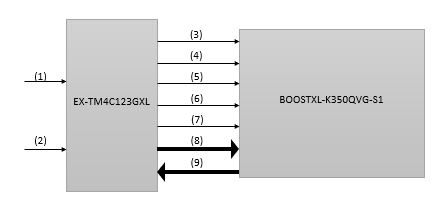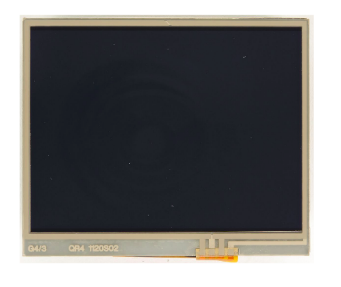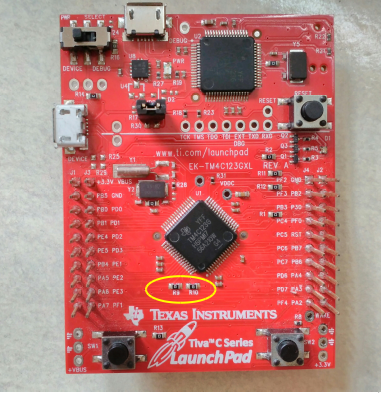Design Requirement
Design a Portable Oscilloscope by interfacing Kentec QVGA Touch Screen Graphics Display and TM4C123GH6PM Evaluation Kit.
Resources Needed
- TIVA C Series Microcontroller (TM4C123GH6PM).
- Kentec QVGA Touch Screen Graphics Display.
- Code Composer Studio IDE.
- GCC.
Project Description
The project implements a two channel Portable Oscilloscope enabled with touch screen. The two channels are sampled by ADC in the micro controller and then the stored ADC data is displayed on the Graphics LCD. The Graphics LCD provides an interactive way to analyse the signals by providing functionalities like Zoom in, Zoom out,and also sliding across each signals separately.
Block Diagram
The block diagram of the system is as shown below:

Block Diagram
Description
- Channel 1 input.
- Channel 2 input.
- Power supply to Display.
- Ground to Display.
- Reset.
- SPI clock input for LCD.
- Chip select signal input for LCD.
- SPI data input for LCD.
- Resistive touch screen data input for micro-controller.
Understanding GLCD interfacing
Introduction
The BOOSTXL-K350QVG-S1 Kentec QVGA Display BoosterPack is an easy-to-use plug-in module with a touch-screen color display.We can use this BoosterPack to start developing applications using the 320×240-pixel TFT QVGA display with resistive touch screen.It uses SPI for communication.
Key Features
- Kentec TFT LCD (part number: K350QVG-V2-F)
- 3.5-inch QVGA (320×240 resolution)
- SPI communication
- 4-wire resistive touch screen
- White LED backlight
- LED backlight driver circuit
- Complies with the BoosterPack standard for use with 20- and 40-pin LaunchPads.
BOOSTXL-K350QVG-S1 Interface
The pin connections to EK-TM4C123GXL is as shown below in tables.
| J1 Pin | Symbol | Description | Note |
|---|---|---|---|
| 1 | 3.3 V | Power supply | |
| 2 | NC | No connection | |
| 3 | NC | No connection | |
| 4 | NC | No connection | |
| 5 | NC | No connection | |
| 6 | NC | No connection | |
| 7 | LCD_SCL | SPI clock input for LCD | |
| 8 | (LCD_SDC) | 4-wire SPI mode DC input for LCD | |
| 9 | NC | No connection | |
| 10 | NC | No connection |
| J2 Pin | Symbol | Description | Note |
|---|---|---|---|
| 11 | TOUCH_YN | Resistive touch screen terminal (Bottom) | |
| 12 | NC | No connection | |
| 13 | LCD_SCS | Chip select signal input for LCD | |
| 14 | NC | No connection | |
| 15 | LCD_SDI | SPI data input for LCD | * |
| 16 | RESET | Reset signal for MCU | |
| 17 | NC | No connection | |
| 18 | NC | No connection | |
| 19 | NC | No connection | |
| 20 | GND | Ground |
| J3 Pin | Symbol | Description | Note |
|---|---|---|---|
| 21 | 5V | Power Supply | |
| 22 | GND | Ground | |
| 23 | TOUCH_YP | Resistive touch screen terminal (Top) | |
| 24 | TOUCH_XP | Resistive touch screen terminal (Left) | * |
| 25 | NC | No connection | |
| 26 | NC | No connection | |
| 27 | NC | No connection | |
| 28 | NC | No connection | |
| 29 | NC | No connection | |
| 30 | NC | No connection |
| J4 Pin | Symbol | Description | Note |
|---|---|---|---|
| 31 | TOUCH_XN | Resistive touch screen terminal (Right) | |
| 32 | LCD_RST | Reset signal input for LCD | |
| 33 | NC | No connection | |
| 34 | NC | No connection | |
| 35 | NC | No connection | |
| 36 | NC | No connection | |
| 37 | NC | No connection | |
| 38 | NC | No connection | |
| 39 | NC | No connection | |
| 40 | LED_ON/OFF | LCD backlight ON/OFF control. |
- *look into description of EK-TM4C123GXL image
The following are the images of GLCD Display,micro-controller and their interface.

BOOSTXL-K350QVG-S1

EK-TM4C123GXL:The yellow circle highlights the R9 and R10 registers.This registers should be removed because for the Tiva C Launchpad / EK-TM4C123GXL application, “LCD_SDI / PB7”has been connected to “TOUCH_XP/PD1” by “R10” on the Launchpad.You must remove “R10” before application

Interfacing:LCD is mounted on controller
Implementation
- Firstly,interface the GLCD display with the TIVA C series launchpad as mentioned above.
- Then, the input analog signals are given as ADC inputs to two different ADC channels.
- Now we need to get the total time period of sampling from the user.
- For the given time period we have to sample the channels and store the data in memory.
- The data of two channel are accessed to display the waveforms on the Graphics LCD.
- We have to write callback functions for the various functionality which we provide though the resistive touch screen.
- The flow chart gives the brief idea of the various functionality which is provided using resistive touch screen.
Frequency limit of operation
- The Oscilloscope Operation in higher frequency range is limited by the ADC’s Sampling rate. The designed Oscilloscope works as desired
upto 30KHz above which aliasing effect kicks in.
Flowchart
The following flow chart gives a overview of function of the designed Portable Oscilloscope.

Problems faced
- Since, we are dealing with analog data, large amount of memory is required to store the sampled data on to memory. So,we cannot sample the data signals for very long time periods.
- The LCD display requires initial Touch screen calibrations.If this is not done properly, touch screen gives many problems.
Demo and Code
The demo is uploaded in the YouTube channel.It demonstrate the working of the Portable Oscilloscope.The link for video is below.
Portable Oscilloscope using BOOSTXL-K350QVG-S1 and EK-TM4C123GXL - https://www.youtube.com/watch?v=fFQUGkLnG4A&feature=youtu.be This is the link for source code - https://github.com/RKaviya/Oscilloscope
Future Scope
- The frequency limit of the Oscilloscope can be increased by having an ADC with higher sampling frequency.
- The number of channels can be increased if display size is increased.
- Additional functionality can also be added like markers, etc.
- Memory allocation for each channel can be increased so as to store waveforms of longer duration.
References
- BOOSTXL-K350QVG-S1 QVGA Display BoosterPack™ Plug-in Module – http://www.ti.com/lit/ug/slau601a/slau601a.pdf
- BoosterPack (BOOSTXL- K350QVG-S1) – http://www.kentecdisplay.com/uploads/soft/Products_spec/BOOSTXL-K350QVG-S1_UserGuide_04.pdf
- TivaWare™ Peripheral Driver Library (User Guide)
- Tiva™ TM4C123GH6PM Microcontroller(Datasheet)
- Tiva™ C Series TM4C123G LaunchPad Evaluation Board(User’s Guide)
- TivaWare™ Graphics Library(User’s Guide) –http://www.ti.com/lit/ug/spmu300d/spmu300d.pdf
- TivaWare ™ Graphics Library Display Drivers –http://www.ti.com/lit/an/spma055/spma055.pdf
Team Members
Kaviya R.
Arvindhan G.

Recent Comments